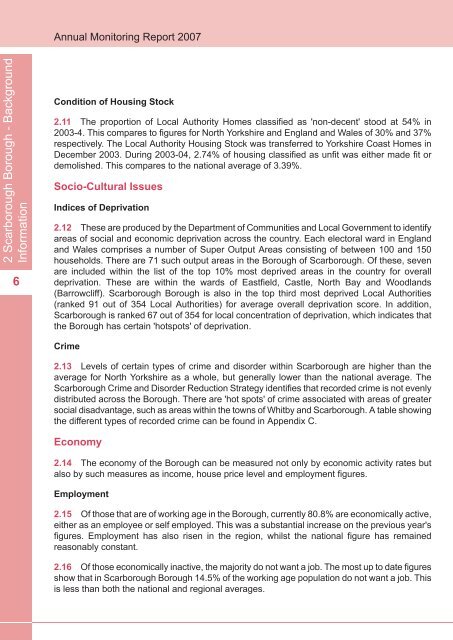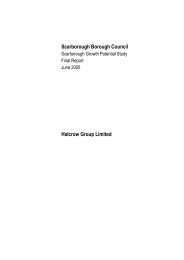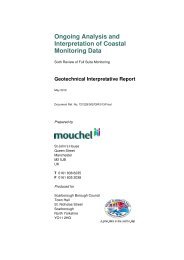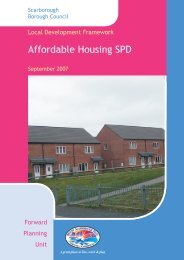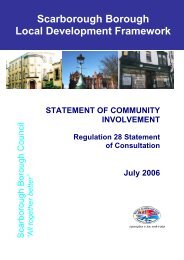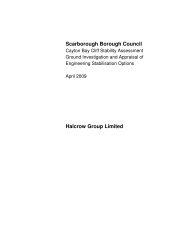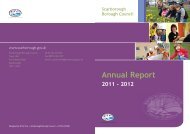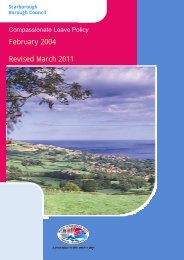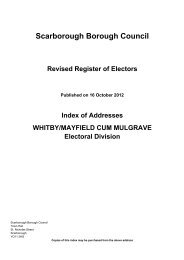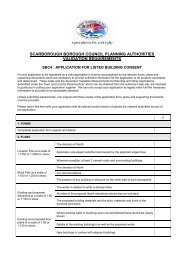Annual Monitoring Report 2007(6.6MB) - Scarborough Borough ...
Annual Monitoring Report 2007(6.6MB) - Scarborough Borough ...
Annual Monitoring Report 2007(6.6MB) - Scarborough Borough ...
You also want an ePaper? Increase the reach of your titles
YUMPU automatically turns print PDFs into web optimized ePapers that Google loves.
<strong>Annual</strong> <strong>Monitoring</strong> <strong>Report</strong> <strong>2007</strong><br />
2 <strong>Scarborough</strong> <strong>Borough</strong> - Background<br />
Information<br />
6<br />
Condition of Housing Stock<br />
2.11 The proportion of Local Authority Homes classified as 'non-decent' stood at 54% in<br />
2003-4. This compares to figures for North Yorkshire and England and Wales of 30% and 37%<br />
respectively. The Local Authority Housing Stock was transferred to Yorkshire Coast Homes in<br />
December 2003. During 2003-04, 2.74% of housing classified as unfit was either made fit or<br />
demolished. This compares to the national average of 3.39%.<br />
Socio-Cultural Issues<br />
Indices of Deprivation<br />
2.12 These are produced by the Department of Communities and Local Government to identify<br />
areas of social and economic deprivation across the country. Each electoral ward in England<br />
and Wales comprises a number of Super Output Areas consisting of between 100 and 150<br />
households. There are 71 such output areas in the <strong>Borough</strong> of <strong>Scarborough</strong>. Of these, seven<br />
are included within the list of the top 10% most deprived areas in the country for overall<br />
deprivation. These are within the wards of Eastfield, Castle, North Bay and Woodlands<br />
(Barrowcliff). <strong>Scarborough</strong> <strong>Borough</strong> is also in the top third most deprived Local Authorities<br />
(ranked 91 out of 354 Local Authorities) for average overall deprivation score. In addition,<br />
<strong>Scarborough</strong> is ranked 67 out of 354 for local concentration of deprivation, which indicates that<br />
the <strong>Borough</strong> has certain 'hotspots' of deprivation.<br />
Crime<br />
2.13 Levels of certain types of crime and disorder within <strong>Scarborough</strong> are higher than the<br />
average for North Yorkshire as a whole, but generally lower than the national average. The<br />
<strong>Scarborough</strong> Crime and Disorder Reduction Strategy identifies that recorded crime is not evenly<br />
distributed across the <strong>Borough</strong>. There are 'hot spots' of crime associated with areas of greater<br />
social disadvantage, such as areas within the towns of Whitby and <strong>Scarborough</strong>. A table showing<br />
the different types of recorded crime can be found in Appendix C.<br />
Economy<br />
2.14 The economy of the <strong>Borough</strong> can be measured not only by economic activity rates but<br />
also by such measures as income, house price level and employment figures.<br />
Employment<br />
2.15 Of those that are of working age in the <strong>Borough</strong>, currently 80.8% are economically active,<br />
either as an employee or self employed. This was a substantial increase on the previous year's<br />
figures. Employment has also risen in the region, whilst the national figure has remained<br />
reasonably constant.<br />
2.16 Of those economically inactive, the majority do not want a job. The most up to date figures<br />
show that in <strong>Scarborough</strong> <strong>Borough</strong> 14.5% of the working age population do not want a job. This<br />
is less than both the national and regional averages.


